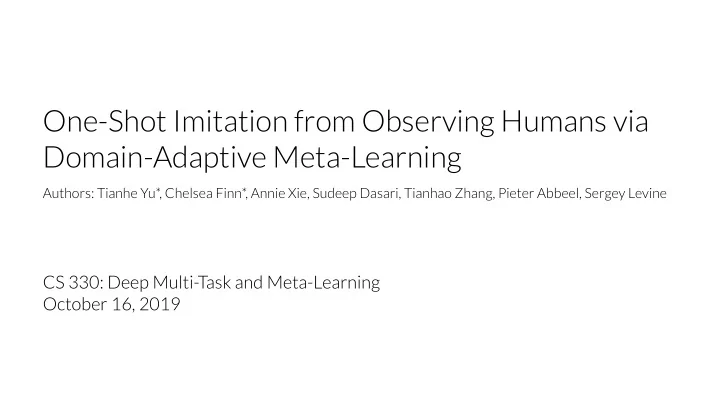

One-Shot Imitation from Observing Humans via Domain-Adaptive Meta-Learning Authors: Tianhe Yu*, Chelsea Finn*, Annie Xie, Sudeep Dasari, Tianhao Zhang, Pieter Abbeel, Sergey Levine CS 330: Deep Multi-Task and Meta-Learning October 16, 2019
Problem: Imitation learning
Problem: Imitation learning Learning from direct manipulation of actions vs
Problem: Imitation learning Learning from direct manipulation of actions vs Learning from visual input
Problem: Imitation learning 1) Visual-based imitation learning often requires a large number of human demonstrations 2) Must deal with domain-shift between different demonstrators, objects, backgrounds, as well as correspondence between human and robot body parts
Goal Meta-learn a prior such that… The robot can learn to manipulate new objects after seeing a single ○ video of a human demonstration ( one-shot imitation ) The robot can generalize to human demonstrations from different ○ backgrounds and morphologies ( domain shift )
End goal Domain-Adaptive Meta-Learning One human demonstration Infer robot policy from human demo
End goal Domain-Adaptive Meta-Learning Human Robot One human demonstrations demonstrations demonstration Infer robot policy from human demo Learn how to infer robot policy from human demo
End goal Domain-Adaptive Meta-Learning Human Robot One human demonstrations demonstrations demonstration Infer robot policy from human demo Learn how to infer robot policy from human demo
End goal Domain-Adaptive Meta-Learning Human Robot One human demonstrations demonstrations demonstration Infer robot policy from human demo Learn how to infer robot policy from human demo
Problem Definition and Terminology Goal is to infer the robot policy parameters that will accomplish the task Learn prior that encapsulates visual and physical understanding of the world ● using human and robot demonstration data from a variety of tasks = (sequence of human observations) ● = (sequence of robot observations, states, and ● actions)
Meta-training algorithm Input: Human and robot demos for tasks from while training do : 1. Sample task 2. Sample human demo INNER LOOP 3. Compute policy params 4. Sample robot demo OUTER LOOP 5. Update meta params Output: Meta params (HOW to infer robot policy from human demo)
Meta-test algorithm Input: 1. Meta-learned initial policy params 2. Meta-learned adaptation objective 3. One video of human demo for a new task Compute policy params via one gradient step Output: Policy params INNER LOOP (robot policy inferred from human demo)
Architecture Overview
Learned temporal adaptation objective
Compared meta-learning approaches: ● Contextual policy ● DA-LSTM policy (Duan. et al.) ● DAML (linear loss) ● DAML (temporal loss)
Results (video)
Exp. 1) Placing, Pushing, and Pick & Place using PR2 Using human demonstrations from the perspective of the robot ●
Exp. 2) Pushing Task with Large Domain Shift using PR2 Using human demonstrations collected in a different room with a different ● camera and camera perspective from that of the robot Critique: Does not explore capability of handling domain shift of baselines
Exp. 3) Placing using Sawyer Used kinesthetic teaching instead of teleoperation for outer loss ● Assessing generality on a different robot and a different form of robot ● demonstration collection 77.8% placing success rate ●
Exp. 4) Learned Adaptation Objective on Pushing Task Experiment performed in simulation and without domain shift to isolate temporal ● adaptation loss
Strengths + Takeaways ● Success on one-shot imitation from visual input of human demonstrations Extension of MAML to domain adaptation by defining inner loss using ○ policy activations rather than actions Learned temporal adaptation objective that exploits temporal information ○ Can do this even if human demonstration video is from a substantially ○ different setting ● Performs well even though amount of data per task is low Can adapt to a diverse range of tasks ○
Limitations ● Has not demonstrated ability to learn entirely new motions Domain-shift due to new background, demonstrator, viewpoint etc. was ○ handled, but the actual behaviors at meta-test time are structurally similar to those at meta-training time ● More data during meta-training could enable better results Few thousand demonstrations but total amount of data per task is quite low ○ ● Still requires robot demos (paired up with human demos) Has not yet solved the problem of learning purely from human demos ○ without the need for any training using robot demos
Discussion questions ● How should we interpret the meta-learned temporal adaptation objective ? What does this meta-learned loss represent? How can we make it more ○ interpretable? ● Can this approach be extended to tasks with more complex actions? Is meta-learning a loss on policy activations instead of explicitly computing ○ the loss on actions sufficient for more complex tasks?
Recommend
More recommend